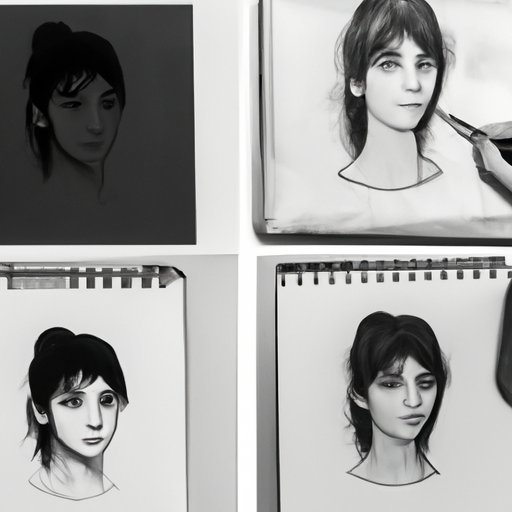
I. Introduction
Drawing a portrait is a rewarding and challenging form of art. A portrait is a representation of a person, animal, or character that captures their likeness and personality. This article is a step-by-step tutorial for beginners who want to learn how to draw a realistic portrait. Whether you are an aspiring artist or just want to learn a new skill, this tutorial will provide you with the tools you need to create beautiful portraits.
II. Step-by-step tutorial
The process of drawing a portrait can seem daunting, but breaking it down into manageable steps can make it much easier. Here are the fundamental steps to follow when drawing a portrait:
Step 1: Sketch the basic shapes of the head and face
Step 2: Add the details of the facial features
Step 3: Shade and highlight to create depth and tone
Step 4: Refine the details and smooth out the sketch
Throughout this tutorial, we’ll offer tips and tricks to help you get the most out of each step. As you work through the tutorial, remember to be patient and take your time.
III. Materials overview
Before starting your portrait, you’ll need to gather some essential materials. The materials you choose will depend on your preferences and budget, but here are the most basic materials for portrait drawing:
– Pencils (HB, 2B, and 4B are recommended)
– Erasers (kneaded and rubber)
– Sketch pad or drawing paper
– Pencil sharpener
There are several different types of pencils, erasers, and paper to choose from, so it’s essential to experiment and find what works best for you. For beginners, we recommend starting with standard graphite pencils and drawing paper.
IV. Tips for capturing likeness
To create a lifelike portrait, it’s essential to capture the likeness of the subject accurately. Here are some tips and techniques for achieving this:
– Pay attention to proportion: This means correctly scaling the size of the facial features to one another. For example, the eyes are usually halfway between the chin and the top of the head.
– Study the angles: The angle of the subject’s head can affect the proportions of the facial features. Make sure to study the angle and perspective before drawing.
– Focus on the details: Small details like the shape of the eyebrows, the curve of the lips, and the contour of the nose are essential in capturing the likeness of the subject.
V. Different styles and approaches
There are several styles and approaches to portrait drawing that you can choose from. Here are a few of the most popular styles:
– Realism: This style aims to capture the subject as accurately as possible.
– Caricature: This style exaggerates the facial features to create a humorous or whimsical effect.
– Comics: This style simplifies the facial features to create a cartoon-like effect.
When choosing a style, consider the purpose of the portrait and the intended effect you want to achieve. For example, a realistic style may be better suited for a professional portrait, while a caricature style may be better for a humorous gift.
VI. Drawing from photographs
Drawing from photographs can be an excellent way to practice portrait drawing. Here are some tips for drawing from photographs:
– Find high-quality reference photos: Photos with high resolution and good lighting will make it easier to capture the details of the subject accurately.
– Interpret the elements: When drawing from a photograph, it’s essential to interpret the elements of the photo rather than copying it exactly. This allows you to add your own style and character to the portrait.
– Be aware of the limitations: Photographs can be limiting when it comes to capturing the character and personality of the subject. Be aware of these limitations and try to add character to the portrait where possible.
VII. Practicing and refining skills
The key to becoming a better portrait artist is practice. Here are some tips for practicing and refining your portrait drawing skills:
– Draw from life: Drawing from real-life subjects can help you capture details and improve your observation skills.
– Experiment with different styles: Trying out different styles and approaches can help you develop your own style and find what works best for you.
– Refine your technique: Spend time perfecting the fundamental skills of portrait drawing, such as shading, proportion, and perspective.
VIII. Conclusion
Learning how to draw a portrait is a challenging but rewarding skill to develop. By following these steps and tips, you can create lifelike and expressive portraits. Remember to be patient and practice regularly to refine your skills.




